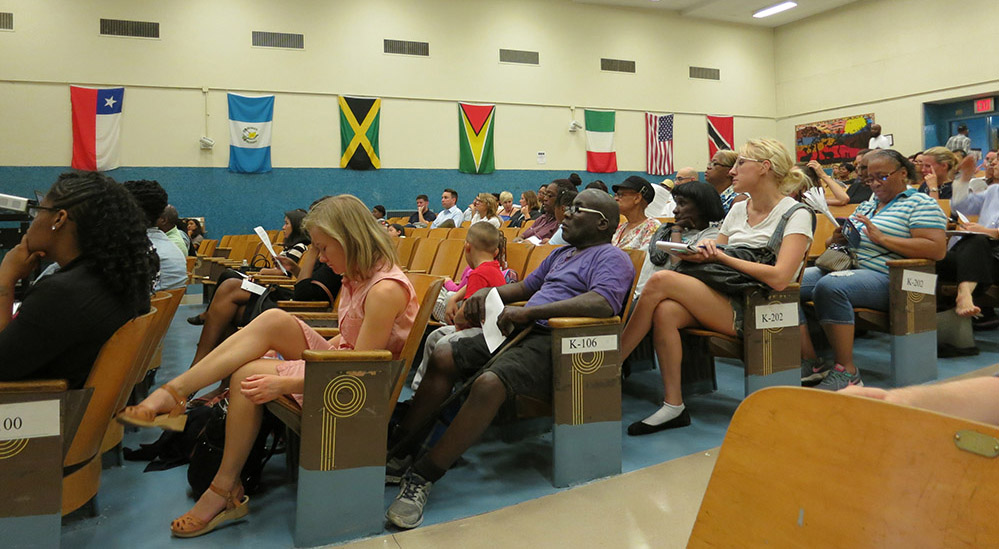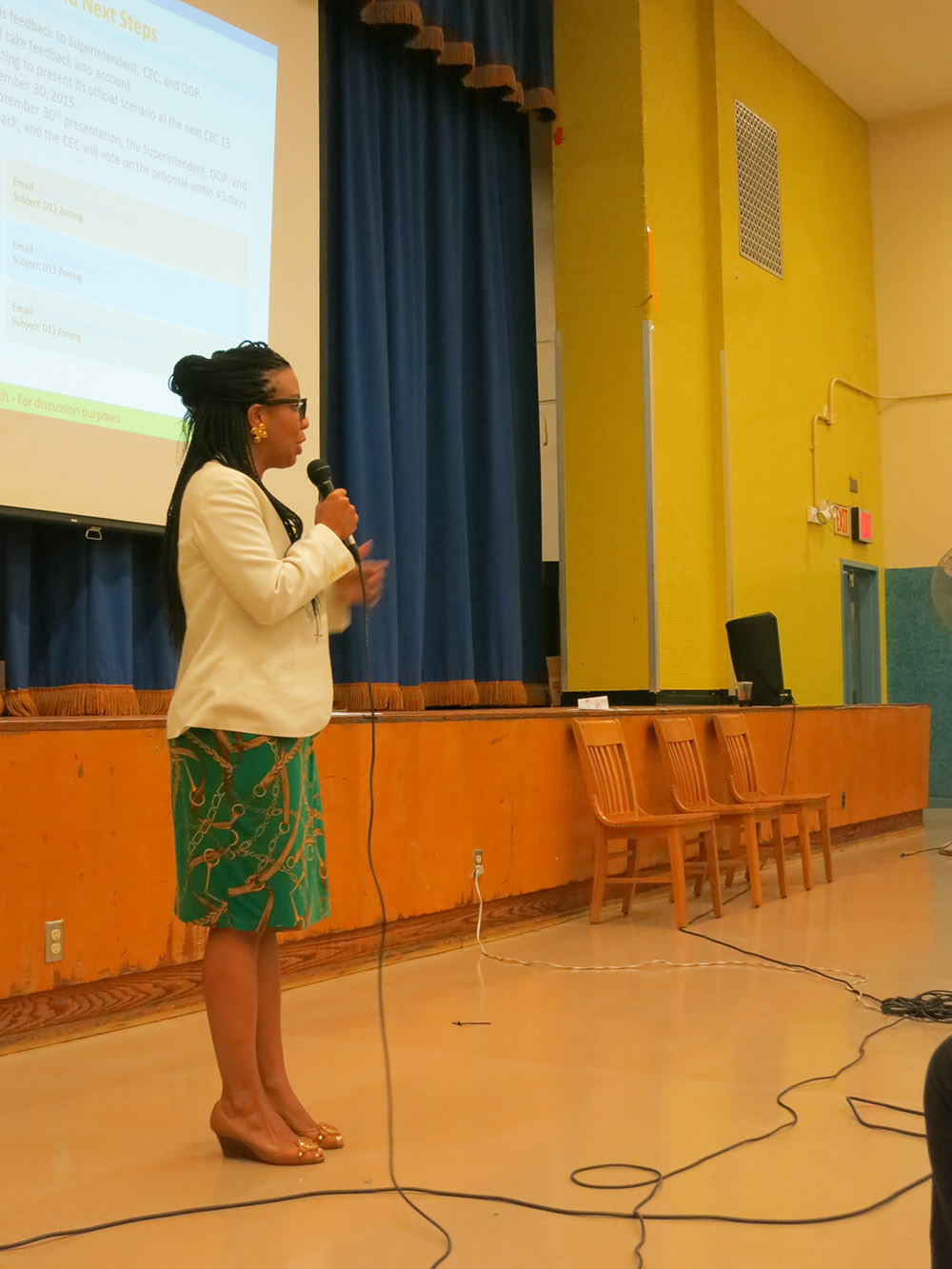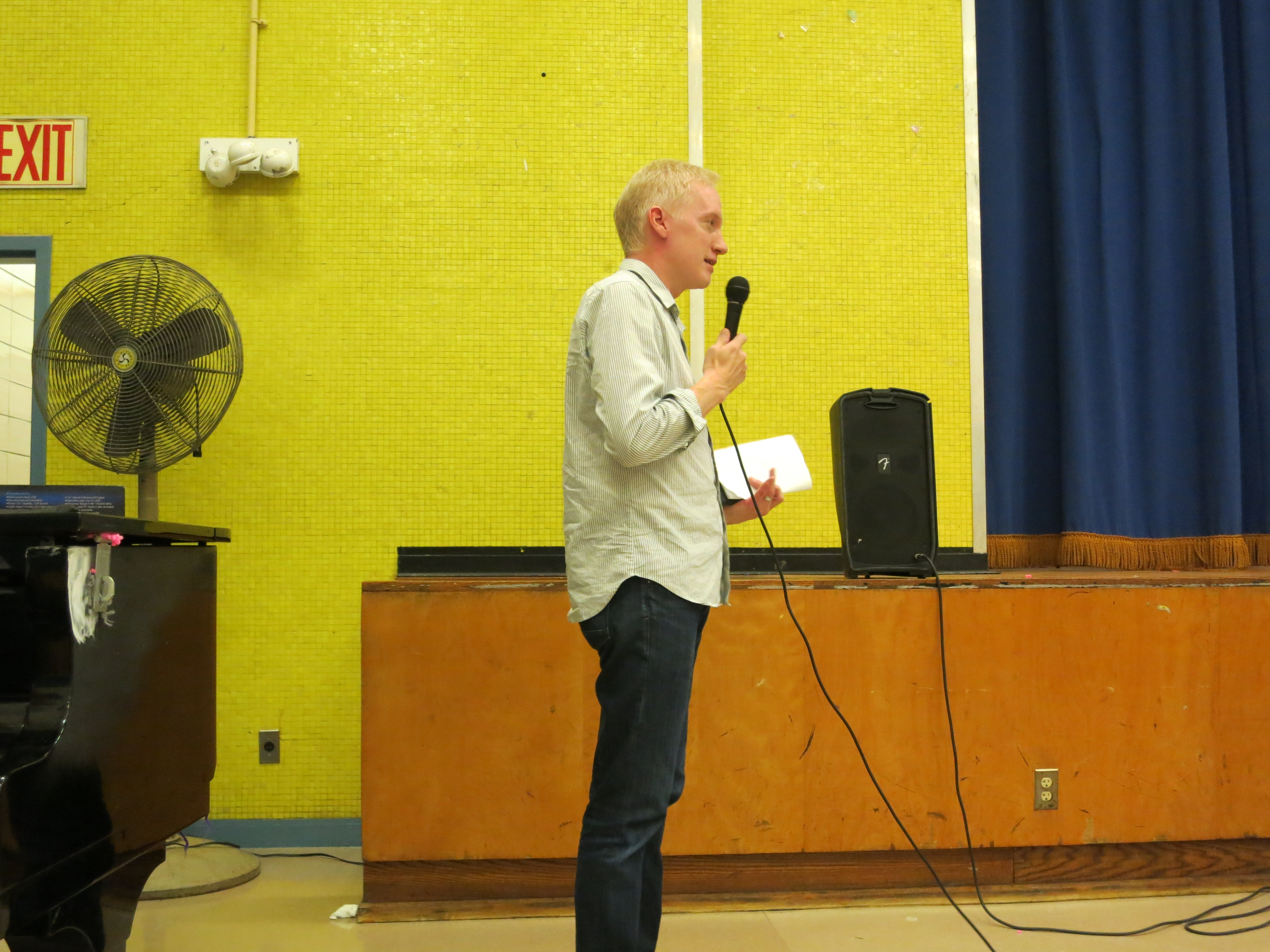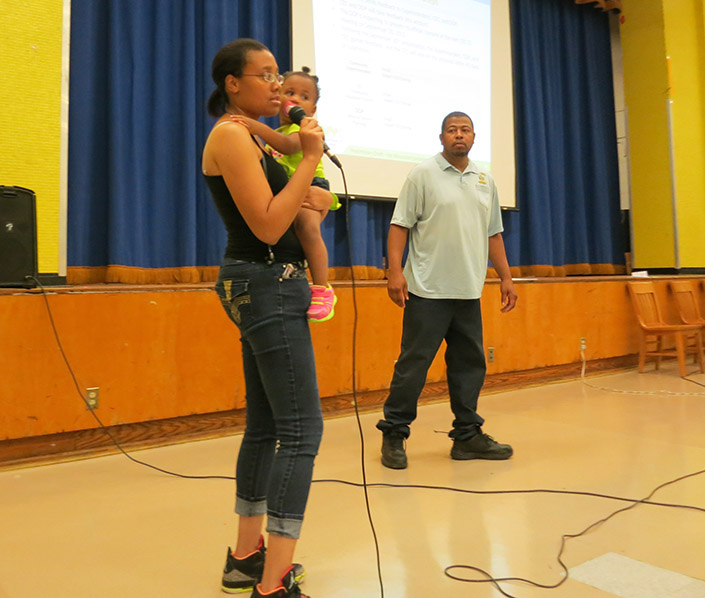P.S. 8 and P.S. 307 School Rezoning Meeting Turns Into Gentrification Debate
A heavily attended town hall meeting Wednesday about the proposed rezoning of P.S. 8 and P.S. 307 turned into an airing of general grievances in regards to gentrification. The meeting, held in the auditorium of P.S. 307, was attended predominantly by concerned parents from the two affected elementary schools, simultaneously representing two halves of a contrasting Brooklyn….

A heavily attended town hall meeting Wednesday about the proposed rezoning of P.S. 8 and P.S. 307 turned into an airing of general grievances in regards to gentrification. The meeting, held in the auditorium of P.S. 307, was attended predominantly by concerned parents from the two affected elementary schools, simultaneously representing two halves of a contrasting Brooklyn.
Brooklyn Heights’ P.S. 8 is overcrowded, and its student body is more than 50 percent white. The school’s zone, which includes Dumbo, is one of the largest in Brooklyn — perhaps a holdover from when Dumbo was not very residential. Vinegar Hill’s P.S. 307, which has one of the city’s smallest zones, has room to grow and services mainly black families, including from the Farragut Houses housing project across the street.
Intended as an informational session, the meeting was led by three officials from the Department of Education’s Office of District Planning, the Community Education Council of District 13, and the parent teacher association of P.S. 307.
A presentation by the suited DOE officials gave attendees an overview of the rezoning process, a rationale for this particular rezoning, and projected zone enrollment and demographic changes. The purpose of the rezoning is to alleviate overcrowding at P.S. 8, they said.
The proposal calls for P.S. 8 to decrease in size and 307 to increase; both schools are expected to have a lower percentage of minorities after the rezoning. For P.S. 8, this means going from a current 34 percent minority student body to a projected 25 to 35 percent minority student body. For P.S. 307, this means going from a current 95 percent minority student body to a projected 55 to 65 percent minority student body.
If enacted, the rezoning proposal will shrink P.S. 8’s zone boundaries and extend P.S. 307’s for a more equal division of the neighborhood. Currently pending approval by the CEC, proposed changes would be enacted for the 2016-2017 school year. Changes would affect only incoming pre-K, kindergarten, and new students.
Following the presentation, a question and answer session became heated, some parents remaining more levelheaded than others, and most expressing a larger dissatisfaction with the schooling system as a whole.
“You don’t have a lot of institutions in America where a majority white people want to function under black leadership,” Reverend Dr. Mark Taylor of nearby Church of the Open Door at 201 Gold Street asserted to thunderous applause. “All of our white brothers and sisters aren’t going to come down to the Farragut Houses and sing kumbaya.”
Such racial tensions were a theme of the night. Multiple commenters mentioned Brown vs. Board of Education, the segregation of New York’s schools, and the racial aspects of gentrification in the neighborhood.
Reverand Taylor called the rezoning proposal, “a P.S. 8 centric plan that leaves out 307.”
Shared concerns among commenters were the rapid implementation of the change and a perceived lack of sufficient notice given to zoned families in both school districts. As well, there was a shared frustration with the rapid development of luxury housing without an improvement in or construction of more local schools.
“You have space in those high rises — put students in ’em,” one P.S. 307 parent called out.
By the end of the meeting, it was clear parents felt they had not been involved in the process, that the rezoning should be delayed by at least a year, and that change and gentrification cause deep frustration and fear of the future.
Parents simultaneously declared a need for new schools while acknowledging their awareness that adequate spaces are available at institutions like P.S. 307. In this way, there was comprehension of the larger situation — Brooklyn’s current state of rapid change — yet no answers as to how to achieve what’s best for individuals and their respective communities.
“Ten years from now people will remember this decision that we make,” said Community Education Council member Horace Allison, “We’ve got to get all the communities moving in the same direction.”
There will be other another meeting regarding the rezoning at P.S. 8 this coming Monday, September 21, from 6:30 to 8 p.m.
Photos by Hannah Frishberg
Related Stories
School Rezoning to Assuage Overcrowding Surprises Dumbo and Vinegar Hill Parents
A Look at Four Recent Brooklyn Elementary School Rezonings
Two Town Hall Meetings Planned for Dumbo School Rezoning
 Council Member Laurie Cumbo
Council Member Laurie Cumbo







Many of the readers refuse to address the same issues that the Bloomberg (and now DeBlasio) administrations did for years; race, but equally as important; class. Here where we live in Park Slope, gentrification did not result in integration, but in the forced removal of families of color. Now we are watching history repeat itself in Prospect Heights, Windsor Terrace and of course downtown. As a former charter and DOE administrator of low-income, minority schools it is fair to say we have one of the worst segregation problems in modern America (I worked with four white middle-class students in fifteen years). A thoughtful and system-wide effort to reform not simply primary admissions, middle-school admissions and but also fair housing based on income (see Cambridge, MA where I also led schools) would make a significant difference in bringing about equity. Ghettos of whites or African-Americans, poor or rich don’t make for pluralist communities. It’s time we stop worrying about just our zones (PS 8 and 307) and get back to the work of changing the system.
Not that I disagree with your core message, but I have to ask – what people of color are being displaced in Windsor Terrace? This neighborhood has historically been middle-class Irish and Italian with very limited racial diversity. The housing stock is also far more owner-occupied rather than rent-based which limits the quick influx of new populations. Neighboring Kensington, on the other hand, is far more diverse, in that case stemming from immigrant populations living in multifamilies.
Furthermore isn’t the recent dual-siting of PS 130 that sought to preserve the zone that straddles WT and Kensington and avoided creating two natural new zones with reduced diversity for both, exactly the type of successful integrated solution that you are advocating? Surprised no-one has raised this example yet…
Many of the readers refuse to address the same issues that the Bloomberg (and now DeBlasio) administrations did for years; race, but equally as important; class. Here where we live in Park Slope, gentrification did not result in integration, but in the forced removal of families of color. Now we are watching history repeat itself in Prospect Heights, Windsor Terrace and of course downtown. As a former charter and DOE administrator of low-income, minority schools it is fair to say we have one of the worst segregation problems in modern America (I worked with four white middle-class students in fifteen years). A thoughtful and system-wide effort to reform not simply primary admissions, middle-school admissions and but also fair housing based on income (see Cambridge, MA where I also led schools) would make a significant difference in bringing about equity. Ghettos of whites or African-Americans, poor or rich don’t make for pluralist communities. It’s time we stop worrying about just our zones (PS 8 and 307) and get back to the work of changing the system.
Not that I disagree with your core message, but I have to ask – what people of color are being displaced in Windsor Terrace? This neighborhood has historically been middle-class Irish and Italian with very limited racial diversity. The housing stock is also far more owner-occupied rather than rent-based which limits the quick influx of new populations. Neighboring Kensington, on the other hand, is far more diverse, in that case stemming from immigrant populations living in multifamilies.
Furthermore isn’t the recent dual-siting of PS 130 that sought to preserve the zone that straddles WT and Kensington and avoided creating two natural new zones with reduced diversity for both, exactly the type of successful integrated solution that you are advocating? Surprised no-one has raised this example yet…
Not entirely true Sir. I was one of the white kids whose parents stayed and enrolled us in PS8 in 1967. If you look at my class pictures there is a pretty even distribution of rich white kids, a few rich black kids and poorer kids from the farrgut projects. Once we hit the Jr. High age – THEN we all went to Packer, St. Ann’s, St. Charles, etc. and the poor kids went to PS7. Maybe you are older and have a different perspective?
Not entirely true Sir. I was one of the white kids whose parents stayed and enrolled us in PS8 in 1967. If you look at my class pictures there is a pretty even distribution of rich white kids, a few rich black kids and poorer kids from the farrgut projects. Once we hit the Jr. High age – THEN we all went to Packer, St. Ann’s, St. Charles, etc. and the poor kids went to PS7. Maybe you are older and have a different perspective?
I think parents need to sit down and start talking to each other now. It may seem silly and small, but the suggestion of focus groups was made at the end of the Town Hall and I think that’s a way forward where the people most affected can come together and start a conversation about what “good integration” looks like and then start taking steps forward to make these changes work for everybody.
If it’s only race and class, then what is the difference between PS287 and PS307? DUMBO parents may be reluctant to send their children to 307 but an increasing number of middle class families of all races are. That’s not the case – or not yet — at PS287. The schools have similar test scores, both schools are so-called “intensely segregated” (as of last year, at least), with 287 having 2% white students and 307 having 7% (up from 4% the year before). PS287 had 84% students qualify for free and reduced lunch and 307 had 85% qualify.
I think parents need to sit down and start talking to each other now. It may seem silly and small, but the suggestion of focus groups was made at the end of the Town Hall and I think that’s a way forward where the people most affected can come together and start a conversation about what “good integration” looks like and then start taking steps forward to make these changes work for everybody.
If it’s only race and class, then what is the difference between PS287 and PS307? DUMBO parents may be reluctant to send their children to 307 but an increasing number of middle class families of all races are. That’s not the case – or not yet — at PS287. The schools have similar test scores, both schools are so-called “intensely segregated” (as of last year, at least), with 287 having 2% white students and 307 having 7% (up from 4% the year before). PS287 had 84% students qualify for free and reduced lunch and 307 had 85% qualify.
This is more a response to well_pHed below, but I couldn’t reply directly to that post for some reason. I think it’s right to say that it’s hard to untangle perceptions of leadership quality from issues of race and class, but even within D13 there are schools that still qualify for Title 1 money and are majority minority that do appeal, and apparently have growing appeal, to an increasingly diverse parent body. PS307 would be one of those — it’s got a tiny zone, so most students come from out of zone but many families have chosen that school because of perceptions (I would say, accurate ones) of strong leadership, good resources and programming; it is still has an overwhelmingly minority population and high free and reduced lunch numbers, but that is already shifting, regardless of a rezone. PS20 is probably another good example (with its French dual language program). PS133 too — but that is probably controversial, and it has a new building in addition to multiple dual language programs. I think we need to take issues of race and class seriously and understand how they play into perceptions of school quality; I also think we need understand what other factors play into perceptions of quality — because it does seem to be about more than simply race and class.